
The Northumberland Strait is a strait in the southern part of the Gulf of Saint Lawrence in eastern Canada. The strait is formed by Prince Edward Island and the gulf's eastern, southern, and western shores.
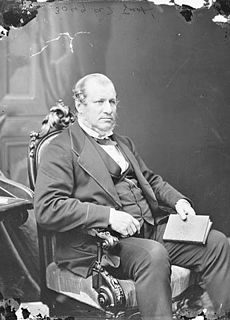
Sir Alexander Tilloch Galt, was a politician and a father of the Canadian Confederation.

The Prince Edward Island Railway (PEIR) was a historic Canadian railway in Prince Edward Island (PEI). The railway ran tip-to-tip on the island, from Tignish in the west to Elmira in the east, with major spurs serving Borden-Carleton's train ferry dock, the capital in Charlottetown, Montague and Georgetown and the original eastern terminus at Souris. A major spur from Charlottetown served Murray Harbour on the south coast.
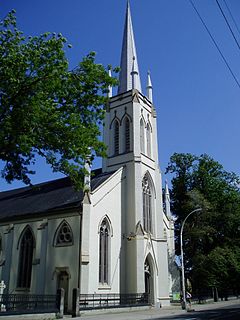
St. Matthew's United Church is a United Church of Canada church in downtown Halifax, Nova Scotia. The church was founded at the same time as the original colony in 1749 as a home for the various groups of dissenting Protestants who were from New England and who did not follow the Church of England. It originally met Sunday afternoons in St. Paul's Church, the Church of England building completed in 1750. The church got its own home in 1754 when a church was constructed at Hollis and Prince streets. This building was destroyed by fire in 1857, and a new church was built at the current location at 1479 Barrington Street, land parcelled off of the Black-Binney House estate by Bishop Hibbert Binney. The church used the Old Burying Ground.
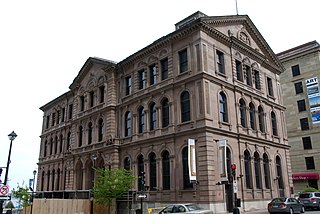
The Art Gallery of Nova Scotia (AGNS) is a public provincial art museum based in Halifax, Nova Scotia, Canada. The art museum's primary building complex is located in downtown Halifax and takes up approximately 6,200 square metres (67,000 sq ft) of space. The museum complex comprises the former Dominion building and two floors of the adjacent Provincial building.

The Maritime Junior Hockey League (MHL) is a Junior A ice hockey league under Hockey Canada, a part of the Canadian Junior Hockey League. It consists of five teams from New Brunswick and one team from Prince Edward Island, which make up the EastLink North Division, and six teams from Nova Scotia which make up the Eastlink South Division. The winner of the MHL playoffs competes for the Fred Page Cup against the winners of the Quebec Junior AAA Hockey League and the Central Junior A Hockey League. The winner of the Fred Page Cup then moves on to compete for the Canadian National Junior A Championship, formerly known as the Royal Bank Cup.

The Guardian is a daily newspaper published six days a week in Charlottetown, Prince Edward Island, Canada.
William Critchlow Harris was an English-born Canadian architect noted mainly for his ecclesiastical and domestic projects in Maritime Canada.
Belfast is a rural municipality in Prince Edward Island, Canada. It is located in southeastern Queens County in the townships of Lot 57 and Lot 58.
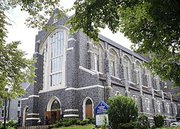
The Cathedral Church of All Saints, also known as All Saints Cathedral, is a cathedral church of the Anglican Church of Canada in Halifax, Nova Scotia.

The history of Prince Edward Island covers several historical periods, from the pre-Columbian era to the present day. Prior to the arrival of Europeans, the island formed a part of Mi'kma'ki, the lands of the Mi'kmaq people. The island was first explored by Europeans in the 16th century. The French later laid claim over the entire Maritimes region, including Prince Edward Island in 1604. However, the French did not attempt to settle the island until 1720, with the establishment of the colony of Île Saint-Jean. After peninsular Acadia was captured by the British in 1710, an influx of Acadian migrants moved to areas still under French control, including Île Saint-Jean.

Charlottetown is the capital and largest city of the Canadian province of Prince Edward Island, and the county seat of Queens County. Named after Queen Charlotte, Charlottetown was an unincorporated town until it was incorporated as a city in 1855.
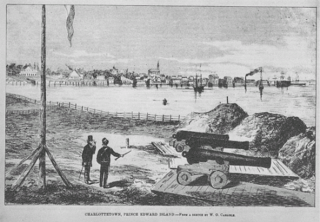
The History of Charlottetown can be traced back to the original French military settlement established on the site in 1720. Over the years Charlottetown has grown to become the largest and most important city on Prince Edward Island.

Three Oaks Senior High School is a Canadian secondary school located in Summerside, Prince Edward Island for students from the eastern part of Prince County, including the City of Summerside.
William Hay was a Scottish architect who was actively working internationally from 1842 to 1887. A specialist in gothic architecture, he is primarily known for his work on several churches and cathedrals. His most famous structure is the Bermuda Cathedral in Hamilton, Bermuda which he designed in 1885. Construction of the cathedral began in 1886 and was completed seven years after Hay's death in 1905. He also designed some of the oldest buildings and structures in Toronto, Ontario, from 1853–1861, and was responsible for the restoration of St. Giles' Cathedral in Edinburgh from 1872–1884. His career exemplifies how the British Empire of the Victorian Era was united not only by military and political strength but also by professionals who took advantage of opportunities in its wide array of territories.
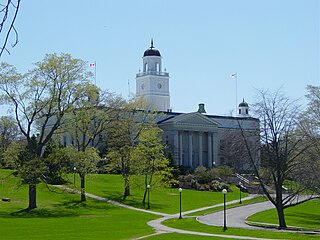
Leslie Raymond Fairn was a Canadian architect whose career is notable for its longevity and for the range of styles it encompassed, including Beaux Arts and Modernism. Most of his work was completed in the Maritimes.

The Grand Parade is an historic military parade square dating from the founding of Halifax in 1749. At the north end of the Grand Parade is the Halifax City Hall, the seat of municipal government in Nova Scotia's Halifax Regional Municipality. At the south end is St. Paul's Church. In the middle of Grand Parade is the cenotaph built originally to commemorate the soldiers who served in World War I.
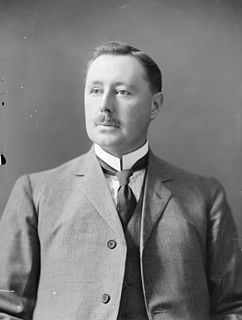
Edgar Lewis Horwood (1868–1957) was a Canadian architect who served as Chief Dominion Architect from 1915 to 1917.
Henry Frederick Busch (1826-1902) was a prominent architect in Halifax, Nova Scotia.
Peter Aloysius McNeil was a Canadian architect and politician. Born in Dominion, Nova Scotia, the eighth son and tenth child of a coal miner, McNeil worked as a farm labourer and carpenter's helper until the Second World War, joining the Royal Canadian Navy and attaining the rank of Shipwright 3rd Class. After completing a correspondence course in architecture while in the Navy, he returned to civilian life as a carpenter, carpenter's foreman, and architect. Professionally, he is most notable as an architect for the Diocese of Antigonish and the Diocese of Charlottetown, for which he built a number of churches and other buildings. He moved from Nova Scotia to Prince Edward Island in 1957, settling in the village of Parkdale, where he would serve as the chairman of the village commission from its inception until 1970. After the death of 5th Queens MLA Elmer Blanchard, McNeil became the Liberal candidate for the riding in the by-election of 23 November 1970; a race he would win. He represented the riding as Councillor until the end of the session, and did not stand for re-election. He continued to practice as an architect, designing schools, seniors' complexes, churches, and recreational centres. He was the first president of the Prince Edward Island Architect's Association, and a fellow of the Institute of Professional Designers. He died in Charlottetown, Prince Edward Island.


















